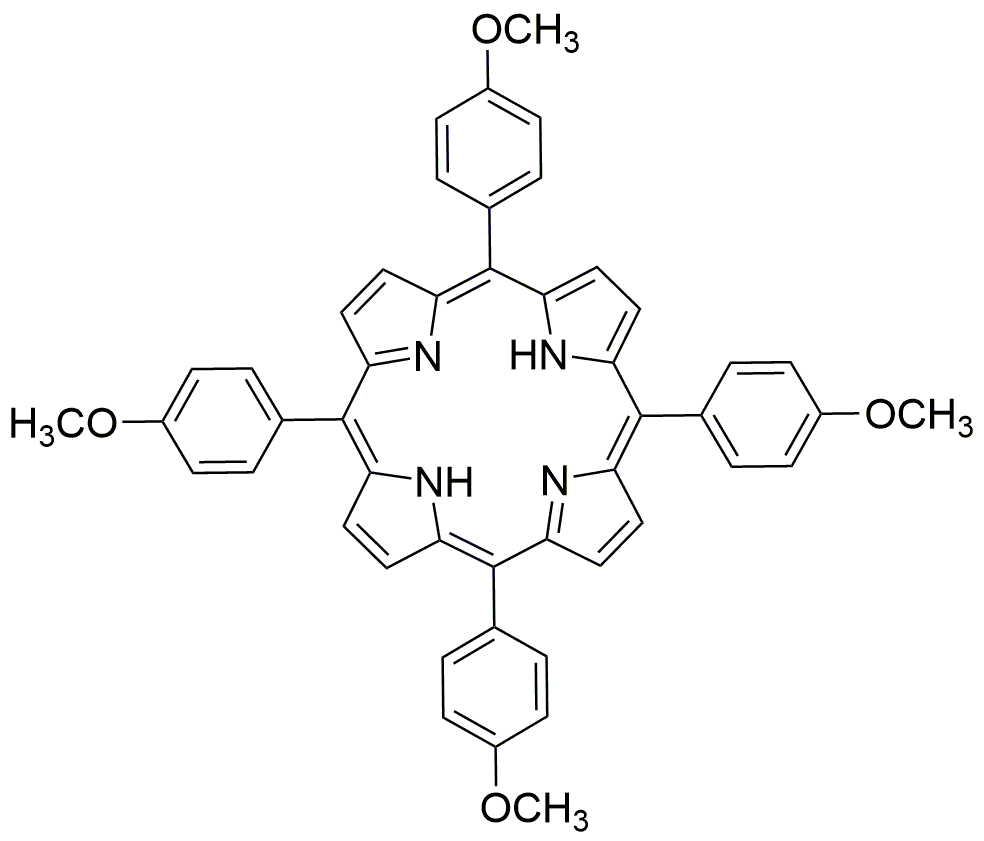5,10,15,20-Tetrakis(4-methoxyphenyl)porphyrin is widely utilized in research focused on:
- Photodynamic Therapy: This compound is effective in treating certain cancers by generating reactive oxygen species when exposed to light, helping to destroy cancer cells while minimizing damage to surrounding healthy tissue.
- Solar Energy Conversion: It plays a key role in the development of organic solar cells, enhancing light absorption and energy conversion efficiency, making renewable energy sources more viable.
- Fluorescent Probes: Used in biological imaging, it serves as a fluorescent marker, allowing researchers to visualize cellular processes and track biomolecules in real-time.
- Catalysis: This compound is employed in various catalytic reactions, improving reaction rates and selectivity in organic synthesis, which is crucial for pharmaceutical and chemical manufacturing.
- Sensor Technology: It is integrated into sensor devices for detecting environmental pollutants, providing a sensitive and selective means of monitoring air and water quality.
Información general
Propiedades
Seguridad y normativas
Aplicaciones
5,10,15,20-Tetrakis(4-methoxyphenyl)porphyrin is widely utilized in research focused on:
- Photodynamic Therapy: This compound is effective in treating certain cancers by generating reactive oxygen species when exposed to light, helping to destroy cancer cells while minimizing damage to surrounding healthy tissue.
- Solar Energy Conversion: It plays a key role in the development of organic solar cells, enhancing light absorption and energy conversion efficiency, making renewable energy sources more viable.
- Fluorescent Probes: Used in biological imaging, it serves as a fluorescent marker, allowing researchers to visualize cellular processes and track biomolecules in real-time.
- Catalysis: This compound is employed in various catalytic reactions, improving reaction rates and selectivity in organic synthesis, which is crucial for pharmaceutical and chemical manufacturing.
- Sensor Technology: It is integrated into sensor devices for detecting environmental pollutants, providing a sensitive and selective means of monitoring air and water quality.
Documentos
Hojas de datos de seguridad (HDS)
La SDS proporciona información de seguridad completa sobre la manipulación, el almacenamiento y la eliminación del producto.
Especificación del producto (PS)
La PS proporciona un desglose completo de las propiedades del producto, incluida la composición química, el estado físico, la pureza y los requisitos de almacenamiento. También detalla los rangos de calidad aceptables y las aplicaciones previstas del producto.
Certificados de análisis (COA)
Busque certificados de análisis (COA) ingresando el número de lote del producto. Los números de lote y de partida se pueden encontrar en la etiqueta de un producto después de las palabras "Lote" o "Lote".
Número de catálogo
Número de lote/lote
Certificados de origen (COO)
Este certificado de origen confirma el país en el que se fabricó el producto y también detalla los materiales y componentes utilizados en él y si se deriva de fuentes naturales, sintéticas u otras fuentes específicas. Este certificado puede ser necesario para cumplir con las normativas aduaneras, comerciales y regulatorias.
Número de catálogo
Número de lote/lote
Hojas de datos de seguridad (HDS)
La SDS proporciona información de seguridad completa sobre la manipulación, el almacenamiento y la eliminación del producto.
DownloadEspecificación del producto (PS)
La PS proporciona un desglose completo de las propiedades del producto, incluida la composición química, el estado físico, la pureza y los requisitos de almacenamiento. También detalla los rangos de calidad aceptables y las aplicaciones previstas del producto.
DownloadCertificados de análisis (COA)
Busque certificados de análisis (COA) ingresando el número de lote del producto. Los números de lote y de partida se pueden encontrar en la etiqueta de un producto después de las palabras "Lote" o "Lote".
Número de catálogo
Número de lote/lote
Certificados de origen (COO)
Este certificado de origen confirma el país en el que se fabricó el producto y también detalla los materiales y componentes utilizados en él y si se deriva de fuentes naturales, sintéticas u otras fuentes específicas. Este certificado puede ser necesario para cumplir con las normativas aduaneras, comerciales y regulatorias.


